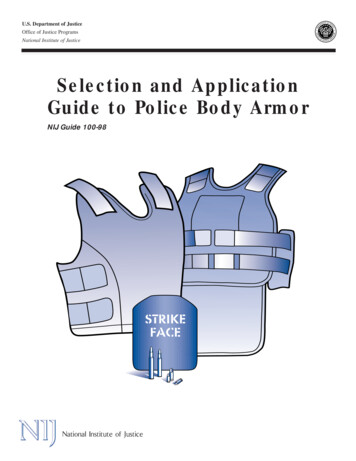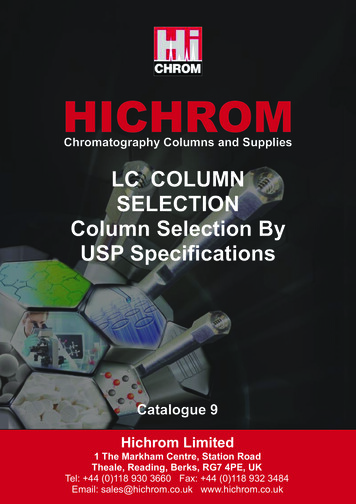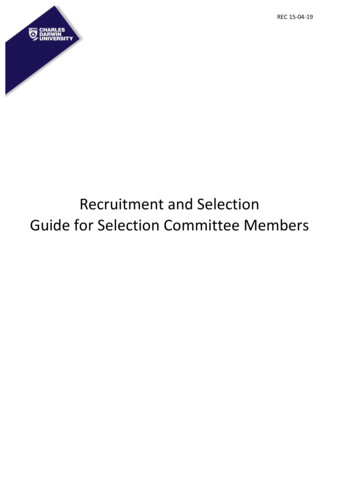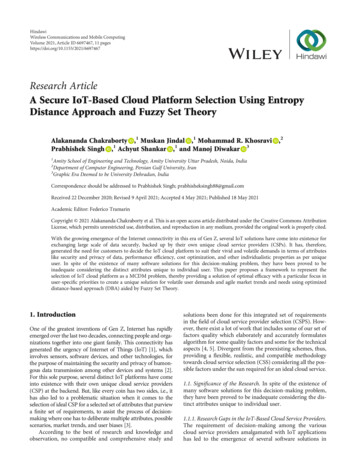
Transcription
National Institute of JusticeSelection and ApplicationGuide to Police Body ArmorNIJ Guide 100-98National Institute of JusticeNT OF JUSSG OVCRAMSDEPANBJ A C EIOF FOffice of Justice ProgramsMERTCETIU.S. Department of JusticeIJJO F OJJ D P B ROJ US T I C E P
U.S. Department of JusticeOffice of Justice Programs810 Seventh Street N.W.Washington, DC 20531Janet RenoAttorney GeneralRaymond C. FisherAssociate Attorney GeneralLaurie RobinsonAssistant Attorney GeneralNoël BrennanDeputy Assistant Attorney GeneralJeremy TravisDirector, National Institute of JusticeOffice of Justice ProgramsWorld Wide Web Sitehttp://www.ojp.usdoj.govNational Institute of JusticeWorld Wide Web Sitehttp://www.ojp.usdoj.gov/nij
U.S. Department of JusticeOffice of Justice ProgramsNational Institute of JusticeSelection and Application Guide toPolice Body ArmorNIJ Guide 100–98(Replaces NIJ Guide 100–87)October 1998Published by:The National Institute of Justice’sNational Law Enforcement and Corrections Technology CenterLance Miller, Testing CoordinatorP.O. Box 1160, Rockville, MD 20849–1160800–248–2742; 301–519–5060NCJ 169587
National Institute of JusticeJeremy TravisDirectorOffice of Science and TechnologyWendy HoweProgram Manager, Standards and TestingThe National Law Enforcement and Corrections Technology Center is supported by Cooperative Agreement 96–MU–MU–K011 awarded by the U.S. Department of Justice, Office of Justice Programs,National Institute of Justice. The products, manufacturers, and organizations discussed in this publication are presented for informational purposes only and do not constitute product approval or endorsement by the National Institute of Justice, U.S. Department of Justice; National Institute of Standards andTechnology, U.S. Department of Commerce; or Aspen Systems Corporation.This publication has been reviewed and approved by the Weapons and Protective Systems Subcommitteeand Executive Committee of the Law Enforcement and Corrections Technology Advisory Council.The National Institute of Justice is a component of the Office of Justice Programs, which also includesthe Bureau of Justice Assistance, the Bureau of Justice Statistics, the Office of Juvenile Justice andDelinquency Prevention, and the Office for Victims of Crime.
SELECTION AND APPLICATION GUIDE TO POLICE BODY ARMORForewordThe National Law Enforcement and Corrections Technology Center (NLECTC) is pleased topresent this updated version of the Selection and Application Guide to Police Body Armor, thefirst revision since 1989. Recognizing the significant advances in ballistic protection materialsand body armor design technology since the last version was published, we believe this guidewill serve as an invaluable tool for law enforcement administrators and procurement officialsresponsible for body armor selection and purchasing. We also strongly encourage trainers andall officers who are issued body armor to review this guide. The guide will enhance their understanding of the benefits of the routine use of body armor, as well as dispel some common mythsand misconceptions regarding body armor selection and use.Many individuals were integral to the development of this guide, either through their directefforts or by providing information about their organizations. We would like to take this opportunity to recognize them:Foremost, a note of appreciation goes to Mr. Lester D. Shubin, formerly Program Manager forStandards of the National Institute of Justice, Mr. Lawrence K. Eliason, formerly the Chiefof the Law Enforcement Standards Laboratory (LESL, now known as the Office of LawEnforcement Standards, or OLES), and to Mr. Daniel E. Frank, formerly Manager of the Protective Equipment Program of the Office of Law Enforcement Standards at the National Institute of Standards and Technology. These men were responsible for preparing the original version of this document, first published in 1987 and revised in 1989.We would also like to thank the following individuals and organizations who provided information that helped to develop this publication:Bill Brierley and Anna Knight, International Association of Chiefs of Police (IACP)/DuPontKevlar Survivors’ Club John Dottore, DuPontCraig Floyd, National Law Enforcement Officers Memorial Fund, Inc.Ray Glaser and Sophie Wray, AlliedSignalSteven Lightsey, National Technical SystemsStephen J. Marquedant, National Quality Assurance, USA Inc.David Hand, Akzo NobelGail Smith, The National “We Care” FoundationCarl Soderstrom, M.D., R. Adams Cowley Shock Trauma CenterCarrie Booth, Bureau of Justice Assistance, Public Safety Officers’ Benefits ProgramBrian A. Reaves, Ph.D., Bureau of Justice StatisticsTom Chancey and Frankie Murphy, Federal Bureau of Investigation, Criminal Justice Information Services Division, Programs Support SectionLance MillerTesting CoordinatorNational Law Enforcement and Corrections Technology Centeriii
SELECTION AND APPLICATION GUIDE TO POLICE BODY ARMORTable of ContentsForeword . . . . . . . . . . . . . . . . . . . . . . . . . . . . . . . . . . . . . . . . . . . . . . . . . . . . . . . . . . . . . . .iiiAbout the National Institute of Justice . . . . . . . . . . . . . . . . . . . . . . . . . . . . . . . . . . . . . . . .viAbout the Law Enforcement and Corrections Standards and Testing Program . . . . . . .viiiAbout the National Law Enforcement and Corrections Technology Center System . . . . .xAbout the Office of Law Enforcement Standards . . . . . . . . . . . . . . . . . . . . . . . . . . . . . . .xii1. Introduction . . . . . . . . . . . . . . . . . . . . . . . . . . . . . . . . . . . . . . . . . . . . . . . . . . . . . . . . . . . .12. Background . . . . . . . . . . . . . . . . . . . . . . . . . . . . . . . . . . . . . . . . . . . . . . . . . . . . . . . . . . . .3A History of Body Armor . . . . . . . . . . . . . . . . . . . . . . . . . . . . . . . . . . . . . . . . . . . . . .3The History of NIJ’s Body Armor Testing Program . . . . . . . . . . . . . . . . . . . . . . . . . . .43. Why Wear Body Armor? . . . . . . . . . . . . . . . . . . . . . . . . . . . . . . . . . . . . . . . . . . . . . . . . . .7The Cost . . . . . . . . . . . . . . . . . . . . . . . . . . . . . . . . . . . . . . . . . . . . . . . . . . . . . . . . . . .7The Threat . . . . . . . . . . . . . . . . . . . . . . . . . . . . . . . . . . . . . . . . . . . . . . . . . . . . . . . . . .8Not Just Bullets . . . . . . . . . . . . . . . . . . . . . . . . . . . . . . . . . . . . . . . . . . . . . . . . . . . . .102,000-Plus Reasons . . . . . . . . . . . . . . . . . . . . . . . . . . . . . . . . . . . . . . . . . . . . . . . . . .114. Body Armor Construction . . . . . . . . . . . . . . . . . . . . . . . . . . . . . . . . . . . . . . . . . . . . . . . .13How Does Body Armor Work? . . . . . . . . . . . . . . . . . . . . . . . . . . . . . . . . . . . . . . . . . .13Methods of Construction . . . . . . . . . . . . . . . . . . . . . . . . . . . . . . . . . . . . . . . . . . . . . .13Materials Used . . . . . . . . . . . . . . . . . . . . . . . . . . . . . . . . . . . . . . . . . . . . . . . . . . . . . .145. The NIJ Standard . . . . . . . . . . . . . . . . . . . . . . . . . . . . . . . . . . . . . . . . . . . . . . . . . . . . . .17Developing the Standard . . . . . . . . . . . . . . . . . . . . . . . . . . . . . . . . . . . . . . . . . . . . . . .17Armor Classification . . . . . . . . . . . . . . . . . . . . . . . . . . . . . . . . . . . . . . . . . . . . . . . . .18Requirements . . . . . . . . . . . . . . . . . . . . . . . . . . . . . . . . . . . . . . . . . . . . . . . . . . . . . . .22Performance Testing . . . . . . . . . . . . . . . . . . . . . . . . . . . . . . . . . . . . . . . . . . . . . . . . . .25V50 Testing . . . . . . . . . . . . . . . . . . . . . . . . . . . . . . . . . . . . . . . . . . . . . . . . . . . . . . . . .26ISO 9000 . . . . . . . . . . . . . . . . . . . . . . . . . . . . . . . . . . . . . . . . . . . . . . . . . . . . . . . . . .27Cooperative Efforts Between NLECTC and Industry . . . . . . . . . . . . . . . . . . . . . . . . .28The Standards Review Process . . . . . . . . . . . . . . . . . . . . . . . . . . . . . . . . . . . . . . . . . .306. The Right Protection . . . . . . . . . . . . . . . . . . . . . . . . . . . . . . . . . . . . . . . . . . . . . . . . . . . .33Selecting the Appropriate Level of Protection . . . . . . . . . . . . . . . . . . . . . . . . . . . . . . .33The “Takeaway” Problem . . . . . . . . . . . . . . . . . . . . . . . . . . . . . . . . . . . . . . . . . . . . . .34Armor Styles . . . . . . . . . . . . . . . . . . . . . . . . . . . . . . . . . . . . . . . . . . . . . . . . . . . . . . .35Comfort and Fit . . . . . . . . . . . . . . . . . . . . . . . . . . . . . . . . . . . . . . . . . . . . . . . . . . . . .37Coverage . . . . . . . . . . . . . . . . . . . . . . . . . . . . . . . . . . . . . . . . . . . . . . . . . . . . . . . . . .38iv
SELECTION AND APPLICATION GUIDE TO POLICE BODY ARMOR7. Purchasing Body Armor . . . . . . . . . . . . . . . . . . . . . . . . . . . . . . . . . . . . . . . . . . . . . . . . .41Overview . . . . . . . . . . . . . . . . . . . . . . . . . . . . . . . . . . . . . . . . . . . . . . . . . . . . . . . . . .41The Procurement Process . . . . . . . . . . . . . . . . . . . . . . . . . . . . . . . . . . . . . . . . . . . . . .42Ensuring Compliance Status . . . . . . . . . . . . . . . . . . . . . . . . . . . . . . . . . . . . . . . . . . . .43Model Procurement Specifications . . . . . . . . . . . . . . . . . . . . . . . . . . . . . . . . . . . . . . .43Protection/Testing Considerations . . . . . . . . . . . . . . . . . . . . . . . . . . . . . . . . . . . . . . . .488. Maintaining Body Armor . . . . . . . . . . . . . . . . . . . . . . . . . . . . . . . . . . . . . . . . . . . . . . . .519. Body Armor Life Expectancy . . . . . . . . . . . . . . . . . . . . . . . . . . . . . . . . . . . . . . . . . . . . .53Body Armor Testing by Departments . . . . . . . . . . . . . . . . . . . . . . . . . . . . . . . . . . . . .5410. Administrative Considerations . . . . . . . . . . . . . . . . . . . . . . . . . . . . . . . . . . . . . . . . . . .59Training and Education . . . . . . . . . . . . . . . . . . . . . . . . . . . . . . . . . . . . . . . . . . . . . . . .59Issuing Body Armor . . . . . . . . . . . . . . . . . . . . . . . . . . . . . . . . . . . . . . . . . . . . . . . . . .60Donating Serviceable Used Armor . . . . . . . . . . . . . . . . . . . . . . . . . . . . . . . . . . . . . . .60Disposing of Body Armor . . . . . . . . . . . . . . . . . . . . . . . . . . . . . . . . . . . . . . . . . . . . . .61Liability . . . . . . . . . . . . . . . . . . . . . . . . . . . . . . . . . . . . . . . . . . . . . . . . . . . . . . . . . . .61When an Officer Is Shot . . . . . . . . . . . . . . . . . . . . . . . . . . . . . . . . . . . . . . . . . . . . . . .62Epilogue . . . . . . . . . . . . . . . . . . . . . . . . . . . . . . . . . . . . . . . . . . . . . . . . . . . . . . . . . . . . . . . .63Endnotes . . . . . . . . . . . . . . . . . . . . . . . . . . . . . . . . . . . . . . . . . . . . . . . . . . . . . . . . . . . . . . . .65Bibliography . . . . . . . . . . . . . . . . . . . . . . . . . . . . . . . . . . . . . . . . . . . . . . . . . . . . . . . . . . . . .67Appendix A: Resource List . . . . . . . . . . . . . . . . . . . . . . . . . . . . . . . . . . . . . . . . . . . . . . . . .69Appendix B: Frequently Asked Questions . . . . . . . . . . . . . . . . . . . . . . . . . . . . . . . . . . . . .73Appendix C: The Effect of Body Armor on the Risk of Fatality inFelonious Assaults on Police Officers . . . . . . . . . . . . . . . . . . . . . . . . . . . . . .77Appendix D: Model Procurement Specifications . . . . . . . . . . . . . . . . . . . . . . . . . . . . . . . .79Appendix E: Body Armor Inspection Sheet . . . . . . . . . . . . . . . . . . . . . . . . . . . . . . . . . . . .83v
SELECTION AND APPLICATION GUIDE TO POLICE BODY ARMORAbout the National Institute of JusticeThe National Institute of Justice (NIJ), a component of the Office of Justice Programs, is theresearch agency of the U.S. Department of Justice. Created by the Omnibus Crime Control andSafe Streets Act of 1968, as amended, NIJ is authorized to support research, evaluation, anddemonstration programs, development of technology, and both national and international information dissemination. Specific mandates of the Act direct NIJ to: Sponsor special projects and research and development programs that will improve andstrengthen the criminal justice system and reduce or prevent crime. Conduct national demonstration projects that employ innovative or promising approaches forimproving criminal justice. Develop new technologies to fight crime and improve criminal justice. Evaluate the effectiveness of criminal justice programs and identify programs that promise tobe successful if continued or repeated. Recommend actions that can be taken by Federal, State, and local governments as well as byprivate organizations to improve criminal justice. Carry out research on criminal behavior. Develop new methods of crime prevention and reduction of crime and delinquency.In recent years, NIJ has greatly expanded its initiatives, the result of the Violent Crime Controland Law Enforcement Act of 1994 (the Crime Act), partnerships with other Federal agenciesand private foundations, advances in technology, and a new international focus. Some examplesof these new initiatives: New research and evaluation is exploring key issues in community policing, violence againstwomen, sentencing reforms, and specialized courts such as drug courts. Dual-use technologies are being developed to support national defense and local law enforcement needs. Four regional National Law Enforcement and Corrections Technology Centers (NLECTC), aBorder Research and Technology Center, and three special offices have joined the NationalCenter in Rockville, Maryland, to form the NLECTC system. The causes, treatment, and prevention of violence against women and violence within thefamily are being investigated in cooperation with several agencies of the U.S. Department ofHealth and Human Services.vi
SELECTION AND APPLICATION GUIDE TO POLICE BODY ARMOR NIJ’s links with the international community are being strengthened through membershipin the United Nations network of criminological institutes; participation in developing theU.N. Criminal Justice Information Network; initiation of UNOJUST (U.N. Online JusticeClearinghouse), which electronically links the institutes to the U.N. network; and establishment of an NIJ International Center. The NIJ-administered criminal justice information clearinghouse, the world’s largest, hasimproved its online capability. The Institute’s Drug Use Forecasting (DUF) program has been expanded and enhanced.Renamed ADAM (Arrestee Drug Abuse Monitoring), the program will increase the numberof drug-testing sites, and its role as a “platform” for studying drug-related crime will grow. NIJ’s new Crime Mapping Research Center will provide training in computer mapping technology, collect and archive geocoded crime data, and develop analytic software. The Institute’s program of intramural research has been expanded and enhanced.The Institute Director, who is appointed by the President and confirmed by the Senate, establishes the Institute’s objectives, guided by the priorities of the Office of Justice Programs, theDepartment of Justice, and the needs of the criminal justice field. The Institute actively solicitsthe views of criminal justice professionals and researchers in the continuing search for answersthat inform public policymaking in crime and justice.vii
SELECTION AND APPLICATION GUIDE TO POLICE BODY ARMORAbout the Law Enforcement and CorrectionsStandards and Testing ProgramThe Law Enforcement and Corrections Standards and Testing Program is sponsored by theOffice of Science and Technology of the National Institute of Justice (NIJ), U.S. Department ofJustice. The program responds to the mandate of the Justice System Improvement Act of 1979,which directed NIJ to encourage research and development to improve the criminal justicesystem and to disseminate the results to Federal, State, and local agencies.The Law Enforcement and Corrections Standards and Testing Program is an applied researcheffort that determines the technological needs of justice system agencies, sets minimum performance standards for specific devices, tests commercially available equipment against those standards, and disseminates the standards and the test results to criminal justice agencies nationwideand internationally.The program operates through the following: The Law Enforcement and Corrections Technology Advisory Council (LECTAC), consisting of nationally recognized criminal justice practitioners from Federal, State, and localagencies, assesses technological needs and sets priorities for research programs and items tobe evaluated and tested. The Office of Law Enforcement Standards (OLES) at the National Institute of Standardsand Technology develops voluntary national performance standards for compliance testing toensure that individual items of equipment are suitable for use by criminal justice agencies.The equipment standards developed by OLES are based upon laboratory evaluation of commercially available products in order to devise precise test methods that can be universallyapplied by any qualified testing laboratory and to establish minimum performance requirements for each attribute of a piece of equipment that is essential to how it functions.OLES-developed standards can serve as design criteria for manufacturers or as the basis forequipment evaluation. The application of the standards, which are highly technical in nature,is augmented through the publication of equipment performance reports and user guides.Individual jurisdictions may use the standards in their own laboratories to test equipment,have equipment tested on their behalf using the standards, or cite the standards in procurement specifications. The National Law Enforcement and Corrections Technology Center (NLECTC), operatedby a grantee, supervises a national compliance testing program conducted by independentlaboratories. The standards developed by OLES serve as performance benchmarks againstwhich commercial equipment is measured. The facilities, personnel, and testing capabilitiesof the independent laboratories are evaluated by OLES prior to testing each item of equipment. In addition, OLES helps NLECTC staff review and analyze data. Test results are published in consumer product reports designed to help justice system procurement officialsmake informed purchasing decisions.viii
SELECTION AND APPLICATION GUIDE TO POLICE BODY ARMORPublications are available at no charge through the National Law Enforcement and CorrectionsTechnology Center. Some documents are also available online through the Justice TechnologyInformation Network (JUSTNET), the center’s Internet/World Wide Web site. To request adocument or additional information, call 800–248–2742 or 301–519–5060, or write:National Law Enforcement and Corrections Technology CenterP.O. Box 1160Rockville, MD 20849–1160E-mail: asknlectc@nlectc.orgWorld Wide Web address: http://www.nlectc.orgix
SELECTION AND APPLICATION GUIDE TO POLICE BODY ARMORAbout the National Law Enforcement and CorrectionsTechnology Center SystemThe National Institute of Justice (NIJ), responding to recommendations from the law enforcement and corrections community, converted its Technology Assessment Program InformationCenter (TAPIC) into the National Law Enforcement and Corrections Technology Center(NLECTC) system, which encompasses the national center, four regional centers, the BorderResearch and Technology Center, the Office of Law Enforcement Standards (OLES), the Officeof Law Enforcement Technology Commercialization (OLETC), and the National Center forForensic Science.These facilities are part of a law enforcement and corrections information network that willmake it easier for agencies and organizations to locate new products and for industry to identifylaw enforcement and corrections requirements.NLECTC’s major responsibilities and goals are to: Work with OLES to establish voluntary standards for selected law enforcement equipmentand to manage voluntary compliance testing programs. Develop critical product databases for law enforcement and corrections that include suchinformation as who manufactures what, who the points of contact are, what testing or evaluation information is available, and what other law enforcement agencies use the product andcan discuss its effectiveness. Assist law enforcement in understanding what technologies are available, how they can beused, and what advantages they offer. Evaluate products such as body armor, firearms, vehicle tires, and handcuffs. Conduct field demonstrations of new law enforcement and corrections technologies. Collect law enforcement and corrections needs and requirements information for use byindustry in developing affordable technologies for law enforcement and corrections. Disseminate information about its resources and services through newsletters, product bulletins, consumer product lists, articles in criminal justice periodicals, exhibits and presentations at criminal justice conferences, and online access. Coordinate the Law Enforcement and Corrections Technology Advisory Council (LECTAC),which is composed of nationally recognized criminal justice professionals from Federal,State, and local law enforcement and corrections agencies. LECTAC helps NIJ set prioritiesfor developing new equipment standards, testing available products, and establishing futureprogram initiatives for NLECTC.x
SELECTION AND APPLICATION GUIDE TO POLICE BODY ARMORTo receive more information or to add your name to the NLECTC mailing list, call800–248–2742 or 301–519–5060, or write:National Law Enforcement and Corrections Technology CenterP.O. Box 1160Rockville, MD 20849–1160E-mail: asknlectc@nlectc.orgWorld Wide Web address: http://www.nlectc.orgThe following is a list of NLECTC regional and affiliated facilities that assist NIJ in fulfillingits mission.NLECTC–Northeast26 Electronic ParkwayRome, NY 13441–4514(p) 888–338–0584(f) 315–330–4315E-mail: nlectc ne@rl.af.milBorder Research and Technology Center225 BroadwaySuite 740San Diego, CA 92101–5005(p) 619–232–1276 or 888–656–2782(f) 619–232–1451 or 888–660–2782E-mail: brtcchrisa@aol.comNLECTC–Southeast7325 Peppermill ParkwayNorth Charleston, SC 29418(p) 800–292–4385(f) 803–207–7776E-mail: nlectc-se@nlectc-se.orgOffice of Law Enforcement TechnologyCommercialization316 Washington AvenueWheeling, WV 26003(p) 888–306–5382(f) 304–243–2131E-mail: oletc@nttc.eduNLECTC–Rocky Mountain2050 East Iliff AvenueDenver, CO 80208(p) 800–416–8086(f) 303–871–2500E-mail: nlectc@du.eduOffice of Law Enforcement StandardsNational Institute of Standards andTechnologyBuilding 225, Room A323Gaithersburg, MD 20899(p) 301–975–2757(f) 301–948–0978E-mail: oles@nist.govNLECTC–Westc/o The Aerospace Corporation2350 East El Segundo BoulevardEl Segundo, CA 90245–4691(p) 888–548–1618(f) 310–336–2227E-mail: nlectc@law-west.orgNational Center for Forensic ScienceP.O. Box 162367Orlando, FL 32816–2367(p) 407–823–6469(f) 407–823–3162E-mail: natlctr@pegasus.cc.ucf.eduxi
SELECTION AND APPLICATION GUIDE TO POLICE BODY ARMORAbout the Office of Law Enforcement StandardsThe Office of Law Enforcement Standards (OLES) was established as a matrix managementorganization in 1971 through a Memorandum of Understanding between the Departments ofJustice and Commerce based upon the recommendations of the President’s Commission onCrime. OLES’ mission is to apply science and technology to the needs of the criminal justicecommunity, including law enforcement, corrections, forensic science, and the fire service.While its major objective is to develop minimum performance standards, which are promulgated as voluntary national standards, OLES also undertakes studies leading to the publication oftechnical reports and user guides.The areas of research investigated by OLES include clothing, communication systems, emergency equipment, investigative aids, protective equipment, security systems, vehicles, weapons,and analytical techniques and standard reference materials used by the forensic science community. The composition of OLES’ projects varies, depending upon priorities of the criminal justice community at any given time and, as necessary, draws upon the resources of the NationalInstitute of Standards and Technology.OLES assists law enforcement and criminal justice agencies in acquiring, on a cost-effectivebasis, the high-quality resources they need to do their jobs. To accomplish this, OLES: Develops methods for testing equipment performance and examining evidentiary materials. Develops standards for equipment and operating procedures. Develops standard reference materials. Performs other scientific and engineering research as required.Since the program began in 1971, OLES has coordinated the development of nearly 200 standards, user guides, and advisory reports. Topics range from performance parameters of policepatrol vehicles, performance reports on various speed-measuring devices, body armor testing, toanalytical procedures for developing DNA profiles.The application of technology to enhance the efficiency and effectiveness of the criminal justicecommunity continues to increase. The proper adoption of the products resulting from emergingtechnologies and the assessment of performance of equipment, systems, methodologies, etc.,used by criminal justice practitioners constitute critical issues having safety and legal ramifications. The consequences of inadequate equipment performance or inadequate test methods canrange from inconvenient to catastrophic. In addition, these deficiencies can adversely affect thegeneral population when they increase public safety costs, preclude arrest, or result in evidencefound to be inadmissible in court.xii
SELECTION AND APPLICATION GUIDE TO POLICE BODY ARMOR1. IntroductionLightweight body armor has been widely available for use by law enforcement personnel formore than 20 years. The dramatic reduction in officer homicides following the introductionof body armor, as shown in exhibit 1, attests to the protection it provides.This success story1extends far beyond protection from handguns—an estimated 2,150 lives have been spared,including cases in which body armor prevented serious injuries to officers from other types ofassaults or accidents.Exhibit 1: Recent Trends in Officer Homicides180Homicide Trend(1964-73 data)140120TAPIC BecomesNLECTCNIJ Std. 0101.03PublishedNIJ Std. 0101.02Published and TAPICEstablishedNIJ Std. 0101.01 Publishedand First Formal TestingProgram Establishedwith IACP20Year Armor Introduced to Field40Year Armor Program Started60NIJ Std. 0101.00 Published80Year Industry User SymposiumTotal Homicides100NIJ EstablishedOfficer Homicides1600'65 '66 '67 '68 '69 '70 '71 '72 '73 '74 '75 '76 '77 '78 '79 '80 '81 '82 '83 '84 '85 '86 '87 '88 '89 '90 '91 '92 '93 '94 '95 '96Year*Source: FBI Uniform Crime Reports: Law Enforcement Officers Killed and Assaulted 1996, 1995, 19942The National Institute of Justice (NIJ) has developed standards for body armor performancethrough its Office of Law Enforcement Standards (OLES). Body armor has been tested as a partof the NLECTC voluntary equipment testing program to determine compliance with the NIJstandard, and NLECTC disseminates those test results and other pertinent information to thelaw enforcement and corrections communities. A consumer product list of3 armor models thatcomply with the requirements of the standard is available from NLECTC.While body armor is a household word in the law enforcement community, questions about itsselection and use are frequently asked. This guide responds to commonly expressed concerns. Itprovides information to help determine what level of protection is consistent with the threats to1
SELECTION AND APPLICATION GUIDE TO POLICE BODY ARMORwhich individual officers are exposed. It also discusses selection of armor from the variety ofstyles available, together with the proper care of armor in service. The NIJ standard is discussedin detail, as well as the use of the standard in armor procurement. In addition, the guide discusses administrative concerns, including the issue of replacing inservice armor, and describes othersources of information.NIJ asks all departments to exercise prudent judgment in selecting armor appropriate to theirneeds. In so doing, NIJ urges proper attention to those factors that affect the wearability ofarmor in order to encourage routine, full-time use by all on-duty officers. The temptation toorder armor that provides more protection than realistically needed should be resisted, becausedoing so may increase the likelihood that the armor will not be worn routinely.2
SELECTION AND APPLICATION GUIDE TO POLICE BODY ARMOR2. BackgroundA History of Body ArmorHumans throughout recorded history have used various types of materials to protect themselvesfrom injury in combat and other dangerous situations. At first, protective clothing and shieldswere made from animal skins. As civilizations became more advanced, wooden shields and thenmetal shields came into use. Eventually, metal was also used as “clothing,” what we now referto as the suit of armor associated with the knights of the Middle Ages. However, with theadvent of firearms (c.1500), most of the traditional protective devices were no longer effective.In fact, the only real protection available against firearms were man-made barriers, such asstone or masonry walls, or natural barriers, such as rocks, trees, and ditches.One of the first recorded instances of the use of soft armor was by the medieval Japanese, whoused armor manufacture
responsible for body armor selection and purchasing. We also strongly encourage trainers and all officers who are issued body armor to review this guide. The guide will enhance their under-standing of the benefits of the routine use of body armor, as well as dispel some common myths and misconceptions regarding body armor selection and use.










